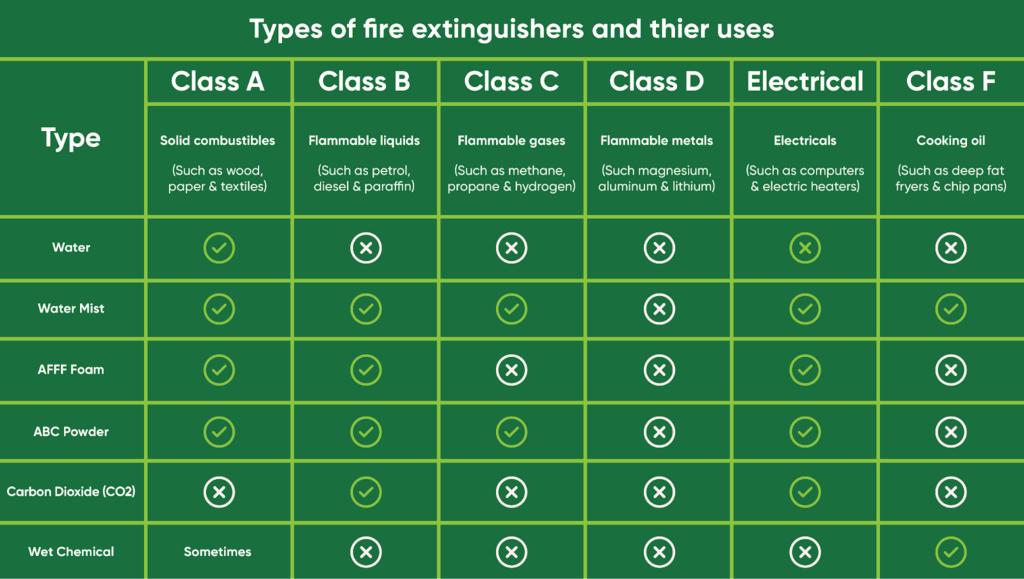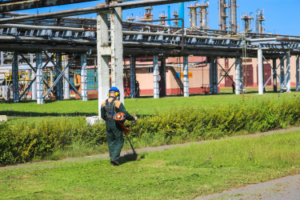Choosing the right type of fire extinguisher for the correct class of fire can be the difference between life and death. It’s also important to have the right extinguishers for your premises, making sure that you select the right sizes and weights, to meet current regulations and UK health and safety laws.
So here’s a useful guide on how to decide between fire extinguisher types, understanding which is the correct one to use in different situations, as well as including colour codes, fire classes and uses.
Fire Extinguisher Types and Classes
Different fire extinguishers were designed to tackle different fires started with different fuel, called ‘classes’ of fire. The fuel that started the fire you need to put out will determine the ‘class of fire’ which will determine the type of fire extinguisher you need.
There are five main fire extinguisher types:
- Water
- Foam
- Dry Powder
- CO2
- Wet Chemical
Although there are five main types of fire extinguisher, there are two versions for the Dry Powder and Water extinguishers for different types of fires. There are a total of eight fire extinguisher types to choose from:
- Water
- Water Mist
- Water Spray
- Foam
- Dry Powder Standard
- Dry Powder Specialist
- CO2
- Wet Chemical
There is no one extinguisher type which works on all classes of fire!
Classes of fire
Fires are categorised into five classes, based on the fuel source that it burns from. Different classes of fires require different extinguishing agents for effective extinguishment and so as to not worsen the effects of the fire.
Using the wrong fire extinguisher can be very dangerous, and can even cause the fire to burn more intensely. To understand the different types of fires and correct method for extinguishing each type we need to understand the different classes of fire:
- Class A: fires caused by or containing flammable solids, like wood, paper, and fabric
- Class B: fires caused by or containing flammable liquids, such as petrol, turpentine or paint
- Class C: fires caused by or containing flammable gases, for example hydrogen, butane or methane
- Class D: fires caused by or containing combustible metals, like magnesium, aluminium or potassium
- Electrical: fires caused by or containing electrical equipment – when the electrical item is removed, the fire changes class
- Class F: fires caused by or containing cooking oils, such as deep fat fryers & chip pans
Which fire extinguisher to use for different classes of fire
No single extinguisher can be used to tackle every class of fire. Because each type of extinguisher has different categories of fire on which it is effective, it’s imperative you understand which extinguisher can be used on which fire.

There are some key rules when understanding fires and fire extinguisher usage:
- Do not use Water extinguishers on liquid or electrical fires
- Foam extinguishers are not suitable for domestic use
- Dry powder extinguishers can be used safely on all classes except for Class F fires. Including electrical fires, up to 1000 volts.
- CO2 extinguishers are safe to use on both high and low voltage fires
- Wet chemical extinguishers are suitable for use on extremely high temperatures and are the only extinguisher type suitable for class F fires
Fire extinguisher colour codes
To understand the colour codes assigned to different fire extinguishers, it’s helpful to first understand what BS EN 3 is.
What is BS EN 3 standard?
BS EN3 requires that at least 95% of the body of the extinguisher must be red (RAL 3000), and the other 5% includes colour coded zones demonstrating the type of fire extinguisher.

Water fire extinguishers have a red label and are suitable for class A fires, meaning they can be used to extinguish fires involving solid combustibles like wood, paper and textiles. Some types of water extinguishers are safe on electrical equipment if they have been di-electrically tested. Otherwise, be sure to take care when using near electrical equipment.


AFFF foam fire extinguishers have a cream label and are effective on class A and class B fires as the foam helps prevent re-ignition. Only foam extinguishers that have been dielectrically tested can be used on electrical appliances.


CO2 extinguishers have a black label and were designed for use on flammable liquid fires, giving them a Class B rating. CO2 extinguishers can also be used on electrical fires, due to CO2 not conducting electricity.

Extinguishers with a blue label are ABC powder fire extinguishers, and can be used on class A, class B, class C making them ideal for use in environments with mixed fire risks. But due to a risk of inhalation when using these extinguishers indoors, powder fire extinguishers are not recommended for use in small rooms, or for domestic use.


De-ionised water mist fire extinguishers have a white label, suitable for fires in class A, B, C as well as burning electrical equipment. Water mist extinguishers are also certified for class F fires, however it’s recommended not to use water mist on anything higher than a 5F rated fire (equivalent to a domestic deep fat fryer).

Extinguishers with a yellow label are wet chemical fire extinguishers. They can sometimes be suitable for Class A fires, but were specifically designed for use on Class F fires, involving burning oil and fat.
Fire inspection from Dependable
Whether you’re due a fire inspection or just want to be on the safe side, Dependable can help out. We can perform full fire safety inspections as regularly as you need, to ensure hazards are reported, safety is prioritised and fires are prevented.
We can also complete a fully comprehensive assessment of the property, including photographic evidence of safety concerns, and passive fire protection provisions. Find out more about our fire services or contact us today!




